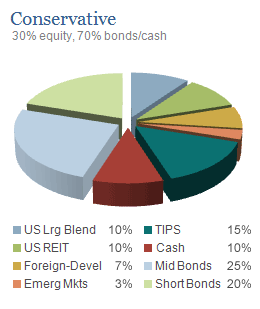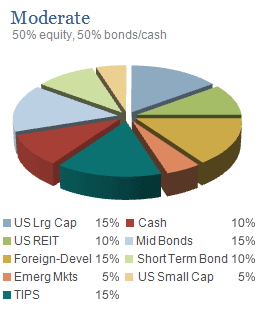how to become an investor
The importance of diversification
Sometimes it seems like the deck is stacked against small or "retail" investors. These investors compete on an uneven playing field against large institutional managers and the people on Wall Street who make the rules of the game. As members of the investing hoi polloi, most individuals would fare best if they followed a diversified asset allocation strategy using mutual funds.
Diversifying across asset classes allows fund investors to mitigate market risk because, the theory goes, different investments perform differently under various conditions. An easy way to get exposure to many different areas of the market is to buy funds that focus on different types of assets — for example, domestic funds containing shares of small, middle-size and large companies, plus international and emerging markets funds. For additional diversification, add other noncorrelating asset classes to the mix, such as real estate investment trusts, or REITs, and bond funds.
To determine your ideal asset allocation strategy, start by assessing your goals, risk tolerance and investing time horizon.
Consider your spending needs

Your tolerance for risk goes hand in hand with what you can afford to lose. Though you may have no problem snoozing through tectonic shifts in the stock market, liabilities on your balance sheet can be hazardous to your financial well-being. Liabilities can appear in the form of debts or future cash needs.
"If you are someone who has a spending need — tuition, spending in retirement — that you can factor in and put a present value on, incorporate that as a liability as you're doing your balance sheet analysis," says Dorsey Farr, Ph.D., investment strategist and portfolio manager at French Wolf & Farr in Atlanta.
"That means that most people can take less risk than they might otherwise think because they have to take into account that planned spending or liability when they're doing asset-liability modeling," he says.
Some people just cannot stomach the thought of losing money even if they own their home and may never need to touch a penny of their investments. Account for your personality when considering risk tolerance to avoid bailing out of high-risk investments at the slightest sign of turbulence.
Time horizon an important factor

In a broad sense, the amount of time you have to invest will dictate your investment strategy.
The retirement portfolio of a 25-year-old is necessarily different from retirement portfolios of 65-year-olds heading into their nonworking years.
"When you're investing, the time frame is extraordinarily important. As we've seen in recent years, you could have the greatest investment in the world, but in a matter of weeks it can come down drastically because of panicked selling that has nothing to do with that company or security," says Paul Mladjenovic, Certified Financial Planner and author of "Stock Investing for Dummies" and the "Unofficial Guide to Picking Stocks."
A recovery can take several years, which may be too long if you have short-term goals such as buying a car or house or funding college.
As a general rule, the more time you have, the more risk you can take.
A conservative strategy for "Retired Ray"

One rule of thumb calls for investors to have the percentage of their portfolio in bonds that represents their age. So a 60-year-old would hold a 60 percent position in fixed income.
With life spans increasing and the very real possibility of being retired for 30 years or more, some investment advisers are recommending more aggressive allocations later in life.
"I have some retirees that still have 60 percent equity positions," says Kevin Brosious, certified public accountant, CFP and president of Wealth Management in Allentown, Pa. "As long as they have the liquidity to pull funds out when they want to, that's fine."
"It's really the lack of liquidity that will kill a plan or not allow a person to realize their goal," he says.
With enough liquidity, long-term investors can ride out market volatility and wait out the recovery.
For an investor who can't afford to take much risk due to time constraints or emotional disposition, a portfolio heavy on the fixed-income side and light on equities can offer some growth with some safety.
The conservative asset allocation model includes equities for growth, REITs and TIPS for inflation protection, and bonds as stabilizers.
A moderate strategy for "Ethel Equilibrium"

A moderate asset allocation strategy involves a higher allocation to stocks than does a conservative strategy. Stocks are generally more risky than bonds for a few reasons.
"An equity is a security which is a residual claim on the assets of a firm. If there is a bankruptcy, other folks get paid before the equity owners. In exchange for coming last in line, there is potentially more upside," says Farr.
Upsides of stocks include possible dividend payments and increases in share price, also called capital appreciation.
To find the best mutual funds for your allocation plan, Mladjenovic recommends first determining the appropriate category and then filtering down the choices from there.
"People often choose the (fund) that is just in the wrong category," he says. He cites an example in which an adviser put his client's college fund into an Internet stocks fund.
"I thought it was a ghastly decision," he says. "In that fund, they could have chosen the greatest Internet stocks in the world, but it was too great a risk," says Mladjenovic.
When evaluating actively managed funds (as opposed to index funds), compare their cost, management tenure and their performance relative to their peers and benchmark.
An aggressive strategy for "Bold Betty"

Stocks aren't the only asset class to consider for investors interested in a growth-oriented portfolio.
The goal of an asset allocation strategy is to have a number of different asset classes with a low correlation to one another. Even if someone is diversified through the entire universe of equities, all can react similarly to a bad business cycle.
"You have to think about the underlying factors that they might be exposed to," says Farr.
Farr recommends that investors consider gold and Treasury securities when looking for assets that are not correlated with the stock market.
Both "would be a safe haven when the economy starts to do poorly. Or gold sometimes responds to concerns about inflation. Treasury securities … are counter-cyclical in that when the economy gets weak, interest rates tend to decline and investors pursue safer assets," Farr says.
Heed this warning, though: In 2008, when the financial crisis unfolded and the stock market tanked, every asset class was adversely affected.
Since that's bound to happen from time to time, your investment plan should be based on the worst-case scenario while you hope for the best.
Investment resources
how to become an investor
Source: https://www.bankrate.com/investing/asset-allocation-for-fund-investors/
Posted by: carlsonyebbeet79.blogspot.com

0 Response to "how to become an investor"
Post a Comment